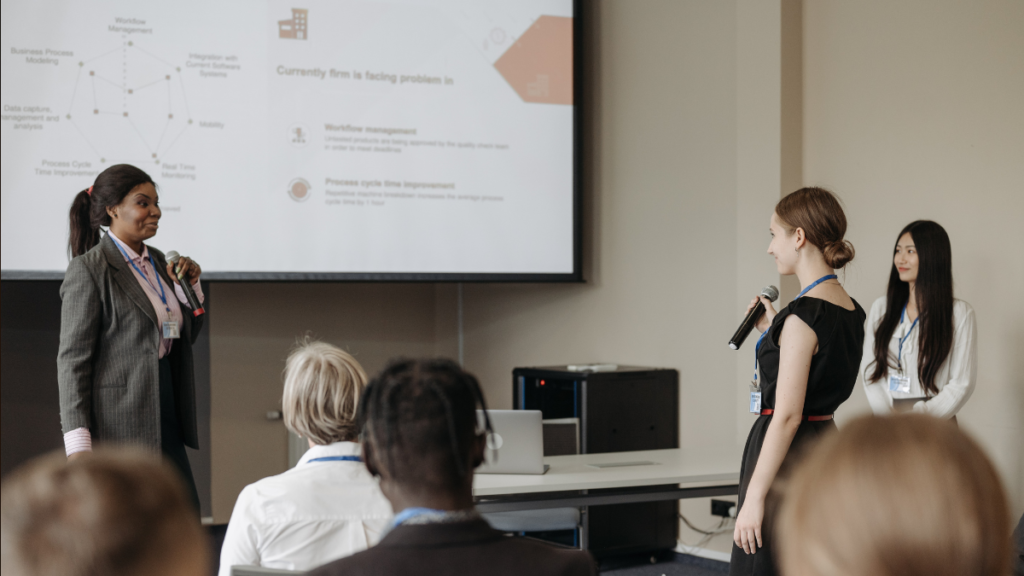The room wasn’t expecting her.
Not because she lacked experience. Not because she didn’t belong. But because no one had thought to imagine her in that role—standing behind the mic, leading the meeting, making the final call.
She adjusted the mic, cleared her throat, and began. And something shifted.
It wasn’t the pitch of her voice or the eloquence of her words—it was the fact that she was speaking at all. In a space where men usually held court, she wasn’t just heard—she was listened to. You could feel the recalibration happening in real time. People sat up straighter. Took notes. Looked at her, then at each other, as if realizing they’d been missing something all along.
This moment—the one where she claimed space that had never quite made room for her—was quiet, but it echoed.
And it begs the question: Why are moments like this still the exception? Why are we still surprised when a woman steps up to the mic or takes her place at the head table?
Visibility shouldn’t feel groundbreaking. It should feel normal. And yet, here we are—still needing to talk about why it matters so much.
Silence doesn’t mean consent—it often means exclusion
Walk into any boardroom, panel discussion, or closed-door meeting and ask yourself a simple question: Who’s missing?
Too often, the answer is women.
Not because they didn’t raise their hands. Not because they lacked the resume or the confidence. But because no one thought to invite them—or worse, they were forgotten entirely. It’s easy to mistake absence for disinterest. But silence, especially in these spaces, doesn’t reflect a lack of voice. It reflects a lack of access.
For every woman who speaks on a stage, there are dozens more who were never handed the mic. For every woman who sits at the decision-making table, how many more are still waiting in the hallway, unsure if they’re even welcome to knock?
This kind of invisibility doesn’t happen loudly. It builds quietly over time—in hiring decisions, speaking lineups, leadership pipelines. It becomes routine. Normalized. Until eventually, it stops raising eyebrows.
And that’s the problem.
Because when women aren’t in the room, perspectives disappear. Lived experiences are ignored. Policies and decisions get made in a vacuum—and they don’t reflect the world as it actually is.
Visibility isn’t a vanity metric. It’s a mirror. And right now, that mirror’s missing half the reflection.
When a woman speaks, she speaks for more than herself
There’s a shift that happens when a young girl hears a woman on stage, unafraid to take up space. It’s not just admiration—it’s recognition. A quiet voice inside says, Maybe that could be me.
That kind of recognition can’t be measured on a spreadsheet, but it sticks. It shapes futures. It opens doors that didn’t even seem to exist before.
Women who speak up—on podcasts, panels, company meetings, or campaign trails—aren’t just telling their stories. They’re cracking open a space where other stories can follow. And every time one woman is visible, it chips away at the idea that leadership should look, sound, or behave a certain way.
It’s not about being inspirational. It’s about being undeniable.
Because when one woman is heard, it challenges the silence around her. It forces people to reimagine who belongs at the front of the room. And that single voice often carries the weight of many who were never given the chance to speak at all.
The head table isn’t just a seat—it’s influence

You can always tell who holds the real power in a room. It’s not about titles. It’s about who gets heard when decisions are on the line.
Too often, the voices shaping strategy, setting budgets, or steering policy don’t reflect the people those decisions impact most. And when women are missing from those tables, the results are felt far beyond the boardroom.
But when they’re present—and truly empowered—it shows.
There’s the executive who paused a rushed product rollout because she saw the blind spot no one else did. The founder who questioned a hiring policy that excluded working mothers. The advisor who shifted the tone of a negotiation because she knew what compromise actually looked like.
These aren’t anecdotes meant to check a diversity box. They’re reminders that influence changes outcomes.
Having women at the head table doesn’t just change the conversation. It changes what gets prioritized, who gets considered, and what gets built. It means policies are more thoughtful. Solutions are more human. Cultures are more inclusive—because the people shaping them actually reflect the world outside.
The consequences of invisibility
It’s easy to miss what’s missing—until something goes wrong.
When women aren’t part of the decision-making process, it doesn’t just leave a gap. It creates real harm. In healthcare, that can mean misdiagnosing symptoms because the clinical trials were built around men. In tech, it shows up as facial recognition tools that can’t identify darker skin tones. In the workplace, it looks like parental leave policies that assume caregiving is someone else’s job.
These blind spots don’t come from malice. They come from rooms where everyone has a similar lens. Where no one thinks to ask a different question because everyone’s lived a similar version of the same answer.
And that’s the danger of invisibility—it makes exclusion look like a coincidence.
When you don’t see women leading, you stop expecting them to. When you don’t hear them speak, you forget to listen. When decisions happen without them, no one notices what’s left out until the damage is already done.
Invisibility is never neutral. It always shapes the outcome.
It’s not about asking for a seat—it’s about making space
Waiting for an invitation only works if someone’s planning to send one.
For a long time, the conversation was about getting women a seat at the table. But the truth is, many women got tired of waiting. So they built their own.
They launched companies, ran for office, started media platforms, created conferences, wrote their own rules. Not because it was trendy—but because no one else was going to make space for them. And in doing so, they didn’t just find their voices—they created platforms where others could speak too.
Visibility isn’t charity. It’s not about giving someone a chance out of obligation. It’s about recognizing the value that’s been overlooked and the brilliance that’s been shut out.
And if you’re someone who does hold the mic—or control the guest list, the budget, the hiring decision—you don’t need to make a grand statement. Sometimes making space means stepping aside. Sometimes it means speaking someone’s name in a room they’re not in. Sometimes it’s as simple as asking, “Who else should be here?”
Because inclusion doesn’t happen by default. It happens when people decide they’re not okay with the silence anymore.
What real visibility looks like
It’s not a headline. It’s not a token keynote slot. Real visibility doesn’t feel like a campaign. It feels like normal life.
You walk into a leadership meeting and see women at the helm—not one, but many. You flip through a conference schedule and find panels where women aren’t the exception. You scroll through your podcast app and hear a range of voices, not just the usual ones. You sit in a classroom and the examples of leadership aren’t limited to one type of story, one kind of name.
Real visibility means women aren’t reduced to symbols. They’re seen as experts, as decision-makers, as people with authority—and not just on “women’s topics,” but across every domain that shapes our world.
It’s the shift from being the only one in the room to being one of many.
And the more it happens, the less it surprises people. That’s the goal—not applause for showing up, but space to lead without having to prove you belong first.
A personal call to action
Think about the rooms you walk into. The podcasts you listen to. The headlines you see. Who gets the spotlight?
And just as importantly—who doesn’t?
You don’t have to run a company or host a show to shift the balance. Sometimes it starts with noticing. Then asking better questions. Then making different choices.
Recommend the woman who’s always quietly leading. Share the voice that isn’t getting enough airtime. Invite someone who’s never been asked. And if you have a mic—use it to pass the mic.
Because visibility isn’t a trend to support. It’s a responsibility to carry.
When more women are seen, more women are heard. When more are heard, more are believed. And when more are believed, things change—for real.
Not someday. Now.




